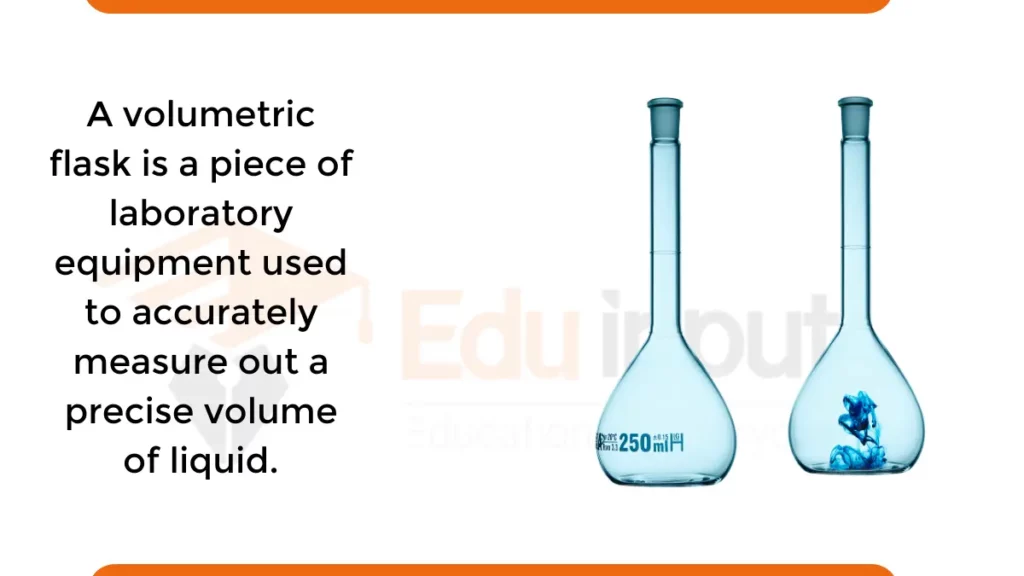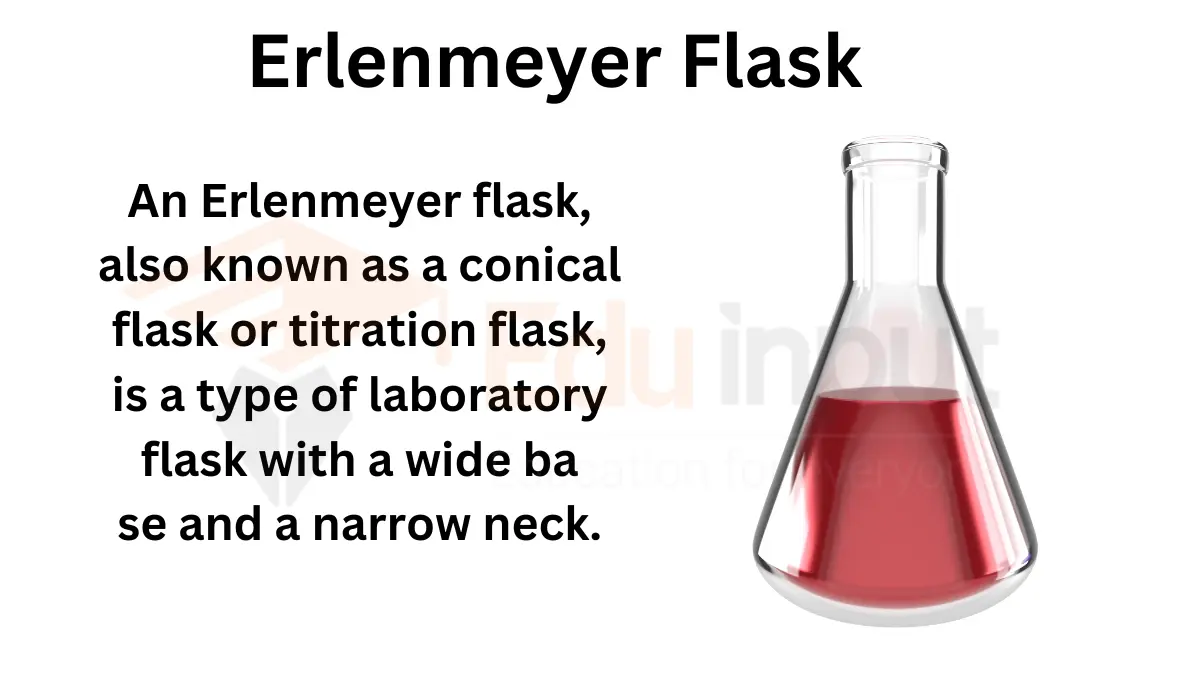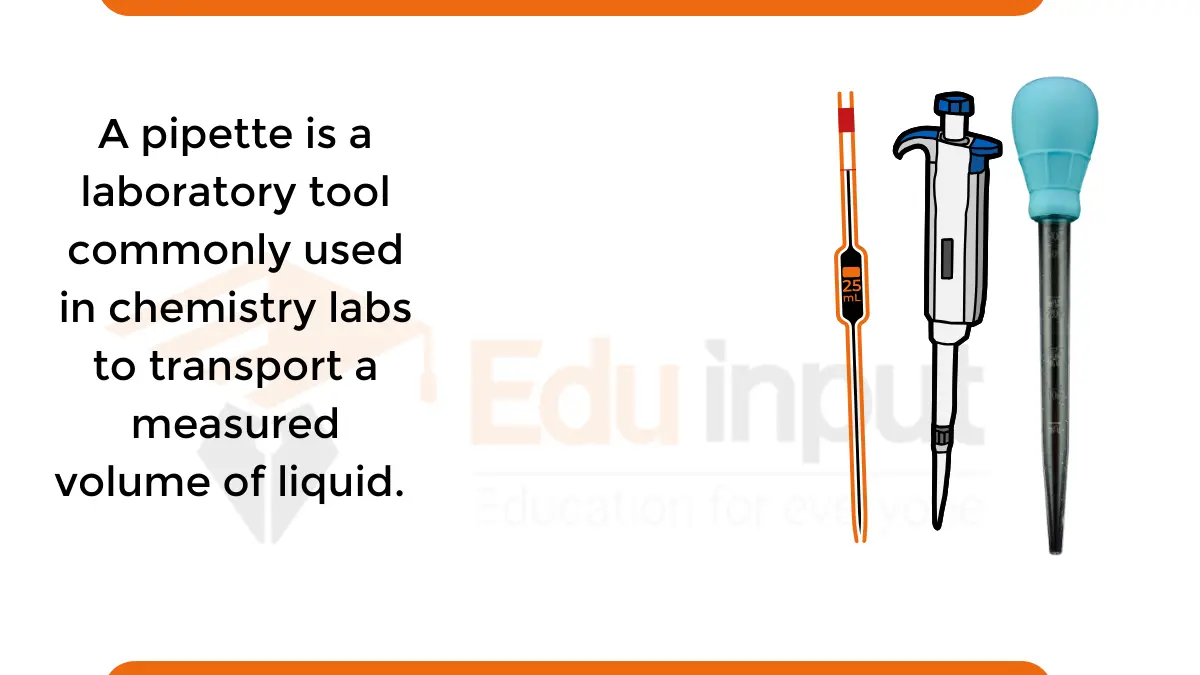Volumetric Flask-Parts, Types, Principle, and Uses
A volumetric flask is a piece of laboratory equipment used to accurately measure out a precise volume of liquid.

Parts of Volumetric Flask
Understanding the parts of volumetric flask helps in identifying its function and purpose.
1. Bulb
The bulb holds the liquid. It has a round or pear shape. The glass surface is smooth and uniform.
2. Neck
The neck pours out the liquid. It is long, narrow and tubular. Its diameter stays the same throughout.
3. Rim and Lip
The rim seals the stopper. The lip pours liquids smoothly. Both are at the top opening.
4. Stopper
The stopper fits tightly into the neck’s opening. It prevents spilling and evaporation. It is often made of polyethylene or PTFE.
5. Calibration Line
The line indicates the calibrated volume. It is etched thinly around the neck’s length. It enables accurate measurements. Calibration confirms the function of volumetric flask in laboratory.
6. Base
The base lets the flask stand upright. It is flat or rounded on the bulb’s bottom. It has a fire-polished finish.
7. Joint
The joint accepts the stopper. It tapers upward on the neck. It creates an airtight seal.
8. Labeling Area
The area holds the label. It sits flat on the body. It identifies contents and volume.
Types Of Volumetric Flask
Here are descriptions of volumetric flask types with at least 2 sentences for each:
1. Class A
Class A flasks provide precise measurements required for analytical chemistry experiments. For example, these flasks are used when preparing standard solutions for titrations because they allow chemists to accurately make solutions with precise concentrations.
2. Class B
Class B flasks offer general accuracy suitable for most lab work and classroom experiments. For example, they are commonly used when preparing reagents for colorimetric analysis experiments since they provide adequate precision for these types of general chemistry labs.
3. Single-Mark
Single-mark flasks have one calibration line that indicates a single volume for accurate measurement of that one volume. These types of flasks are ideal when only one specific volume is required for an experiment such as making calibration standards or filling a precise amount for a reaction.
4. Double-Mark
Double-mark flasks have two calibration lines that enable accurate measurement of two different volumes. For example, these flasks are useful in acid-base titration experiments because they allow precise preparation of both the acid and base solutions.
5. Triple-Mark
Triple-mark flasks have three calibration lines that permit accurate measurements of three different volumes. They are useful when multiple precise volumes are needed such as when making a dilution series or preparing a range of reagent concentrations.
6. Tear-Drop
Tear-drop flasks have a rounded bulb shape that prevents liquid retention and improves accuracy, making them ideal for experiments requiring very small yet highly precise volumes. For example, these flasks are commonly used in trace metal analysis where tiny, accurate volumes are critical.
How to Use Volumetric Flask?
Volumetric flask use involves cleaning, measuring, and calibrating.
Preparing the volumetric flask
- Clean the volumetric flask thoroughly with soap and water. Rinse it well with distilled water and let it air dry.
- Inspect the volumetric flask for any cracks or chips. If you find any damage, do not use the flask.
- Use a funnel to transfer the liquid you want to measure into the volumetric flask.
- Add enough liquid to the flask so that the bottom of the meniscus (the curved surface of the liquid) is slightly below the graduation ring.
Measuring the volume of a liquid
- Hold the volumetric flask at eye level and look at the meniscus from the side.
- Adjust the volume of the liquid until the bottom of the meniscus is exactly at the graduation ring.
- If the volume is too high, use a Pasteur pipette to remove some of the liquid. If the volume is too low, add more liquid using a funnel.
Calibrating the volumetric flask
Calibration confirms the function of volumetric flask in laboratory:
- Weigh the empty volumetric flask.
- Fill the volumetric flask with distilled water to the graduation ring.
- Weigh the volumetric flask again.
- Calculate the mass of the distilled water by subtracting the mass of the empty flask from the mass of the flask filled with water.
- Divide the mass of the distilled water by its density (0.99707 g/mL) to determine the volume of the flask.
Cleaning Volumetric Flasks
Rinse volumetric flasks thoroughly with distilled water after each use. Allow them to air dry completely. Do not scrub or touch the calibration line during cleaning to avoid damaging or altering the accuracy. The calibration line should remain pristine.
Troubleshooting Volumetric Flasks
Inspect volumetric flasks regularly for any chips, cracks, or scratches which can affect accuracy. Check that the stopper maintains a tight seal when inserted to prevent evaporation or leakage.
Recalibrate each flask on a routine basis by weighing or measuring a precise volume of water to ensure the calibration line remains accurate over time and with repeated use. Adjust any flasks that fall out of calibration.
Experiments Using Volumetric Flasks
Here are some examples of experiments in which volumetric flasks are used:
1. Preparing Standard Solutions
Preparing Standard Solutions is the core volumetric flask purpose.
Use a volumetric flask when preparing standard solutions to ensure accuracy in the concentration. Measure out the desired mass of solute using an analytical balance, transfer it quantitatively to the volumetric flask, and dilute to the calibration line with solvent to achieve the exact target concentration.
2. Titrations
Use volumetric flasks to precisely prepare both the titrant and analyte solutions for titrations. For example, dilute a concentrated acid or base stock solution in a volumetric flask to make the titrant of known concentration. Also prepare the analyte solution in a volumetric flask to have an accurately known initial concentration.
3. Diluting Concentrated Acids/Bases
First carefully add the concentrated acid or base to the volumetric flask using a pipette. Never add water directly to the concentrated stock solution. Then fill the flask to the calibration line with water to quantitatively dilute the acid/base solution to the desired lower concentration. The volumetric flask allows accurate calculation of the diluted concentration.
Uses of Volumetric Flasks
Here are some key uses of volumetric flasks in laboratory:
- Preparing solutions of precise concentration – The accurate volume measurements of volumetric flasks allow chemists to calculate exact molarities when making standard solutions.
- Performing titrations – Volumetric flasks permit precise preparation of both titrant and analyte solutions for titrations. The concentrations must be known accurately to determine the equivalence point.
- Diluting stock solutions – Concentrated reagents can be diluted quantitatively using volumetric flasks to achieve exact working concentrations.
- Making calibration standards – Standards for instrument calibration need to be made carefully. Volumetric flasks allow accurate concentrations.
- Preparing reagents for analysis – Many analytical methods require reagents of known concentrations. Volumetric flasks provide the needed precision.
- Calculating solution stoichiometry – The number of moles of solute in a solution prepared with a volumetric flask can be determined from the concentration and volume.
- Ensuring reproducibility – Volumetric flasks allow solutions to be prepared identically time after time by different chemists.
- Mixing multiple solutions – Two or more solutions can be combined and mixed quantitatively using volumetric flasks.
- Maximizing accuracy in small volumes – The narrow necks and calibration lines permit careful measurement even at milliliter or microliter volumes.







Leave a Reply